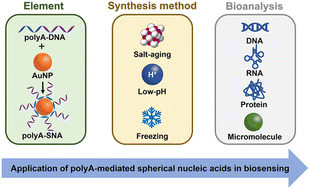Owing to the versatile photophysical and chemical properties, spherical nucleic acids (SNAs) have been widely used in biosensing. However, traditional SNAs are formed by self-assembly of thiolated DNA on the surface of a gold nanoparticle (AuNP), where it is challenging to precisely control the orientation and surface density of DNA. As a new SNA, a polyadenine (polyA)-mediated SNA using the high binding affinity of consecutive adenines to AuNPs shows controllable surface density and configuration of DNA, which can be used to improve the performance of a biosensor. Herein, we first introduce the properties of polyA-mediated SNAs and fundamental principles regarding the polyA–AuNP interaction. Then, we provide an overview of current representative synthesis methods of polyA-mediated SNAs and their advantages and disadvantages. After that, we summarize the application of polyA-mediated SNAs in biosensing based on fluorescence and colorimetric methods, followed by discussion and an outlook of future challenges in this field.
